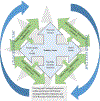Opioid use disorder research and the Council for the Advancement of Nursing Science priority areas
- PMID: 32279897
- PMCID: PMC7484386
- DOI: 10.1016/j.outlook.2020.02.001
Opioid use disorder research and the Council for the Advancement of Nursing Science priority areas
Abstract
Background: Chronic diseases, such as opioid use disorder (OUD) require a multifaceted scientific approach to address their evolving complexity. The Council for the Advancement of Nursing Science's (Council) four nursing science priority areas (precision health; global health, determinants of health, and big data/data analytics) were established to provide a framework to address current complex health problems.
Purpose: To examine OUD research through the nursing science priority areas and evaluate the appropriateness of the priority areas as a framework for research on complex health conditions.
Method: OUD was used as an exemplar to explore the relevance of the nursing science priorities for future research.
Findings: Research in the four priority areas is advancing knowledge in OUD identification, prevention, and treatment. Intersection of OUD research population focus and methodological approach was identified among the priority areas.
Discussion: The Council priorities provide a relevant framework for nurse scientists to address complex health problems like OUD.
Keywords: Big data and Data analytics; Determinants of health; Global health; Opioid use disorder research; Precision health.
Copyright © 2020 Elsevier Inc. All rights reserved.
Figures
Similar articles
-
National nursing science priorities: Creating a shared vision.Nurs Outlook. 2017 Nov-Dec;65(6):726-736. doi: 10.1016/j.outlook.2017.06.002. Epub 2017 Jun 12. Nurs Outlook. 2017. PMID: 28711216
-
American Heart Association: Scientific Council of Cardiovascular Nursing.J Cardiovasc Nurs. 2009 May-Jun;24(3):252-5. doi: 10.1097/JCN.0b013e31819f5818. J Cardiovasc Nurs. 2009. PMID: 19390344 No abstract available.
-
Research Agenda of the Oncology Nursing Society: 2019-2022.Oncol Nurs Forum. 2019 Nov 1;46(6):654-669. doi: 10.1188/19.ONF.654-669. Oncol Nurs Forum. 2019. PMID: 31626621
-
Opioid use disorder education for acute care nurses: An integrative review.J Clin Nurs. 2020 Sep;29(17-18):3122-3135. doi: 10.1111/jocn.15372. Epub 2020 Jul 10. J Clin Nurs. 2020. PMID: 32533719 Review.
-
Research priorities for Australian critical care nurses: do we need them?Aust Crit Care. 2004 Nov;17(4):142-4, 146, 148-50. doi: 10.1016/s1036-7314(04)80019-5. Aust Crit Care. 2004. PMID: 18038523 Review.
Cited by
-
The evolution of Big Data in neuroscience and neurology.J Big Data. 2023;10(1):116. doi: 10.1186/s40537-023-00751-2. Epub 2023 Jul 10. J Big Data. 2023. PMID: 37441339 Free PMC article.



